Green and Gold - Chrysogonum virginianum
|
Chrysogonum virginianum - Green and Gold. Chrysogonum is a monospecific genus native to the eastern United States. In the past some authorities have separated the genus into two species based, I think, on whether or not the plant was stoloniferous - C. virginianum, without stolons, and C. australe, stoloniferous.) Now the plant is classified into three varieties:
- C. virginianum var. virginianum is non-stoloniferous. It is the shortest of the varieties, with the leafy clumps growing up to about 16 inches high, and the flowering stems can reach 2 feet. The early flowering stems do not have leaves, but later stems are leafy. It is a more northern variety, with little or no overlap with var. australe. It is sometimes known as Northern Green and Gold or Virginia Green and Gold.
- var. brevistolon is the intermediate variety, including its range, which overlaps with both of the other varieties. It has stolons with shorter stolon internodes than var. australe.. While it is stoloniferous like var. australe, it is taller than that variety, although not as tall as the tallest of var. virginianum, and like this latter variety, its flowering stems develop leaves as the plant ages. It is sometimes known as Carolina Green and Gold, appropriate since this is the "middle variety" in pretty much all ways, including range.
- var. australe is stoloniferous with relatively long stolon internodes. It is the shortest variety, with the flowering stems rarely growing more than 5 inches tall, and they do not develop leaves on the flowering stems. This southernmost variety is sometimes known as Gulf Coast Green and Gold, since it is known only in the Gulf Coast states, plus Georgia.
Chrysogonum virginianum - all three varieties - are used in flower gardens as a groundcover, both for their foliage and beautiful bright golden-yellow flowers. It is listed as Endangered in KY, OH, PA, and TN.
Found in:
AL, DC, FL, GA, KY, LA, MD, MS, NC, NY, OH, PA, SC, TN, VA, WV
Leave comments on Chrysogonum virginianum at this link. | 
Distribution of Chrysogonum virginianum in the United States and Canada:

Map courtesy of The Biota of North America Program.
Map color key
Search Our Database: Enter any portion of the Scientific, Common Name, or both.
Do a general Google search of the entire site:
#ad
 Follow USWildflowers on Twitter
#ad
| | Site: Murray County, GA Date: 2015-April-17 | Photographer: Gerald C. Williamson
Nikon D7000
Tamron SP 90MM f/2.8 AF Macro | | Chrysogonum virginianum is clearly a member of Asteraceae. It has 5 (occasionally 6) golden yellow ray florets (the "petals"), and up to 50 disc florets. The corolla of the disc floret is also golden yellow, and has 5 lobes. | | 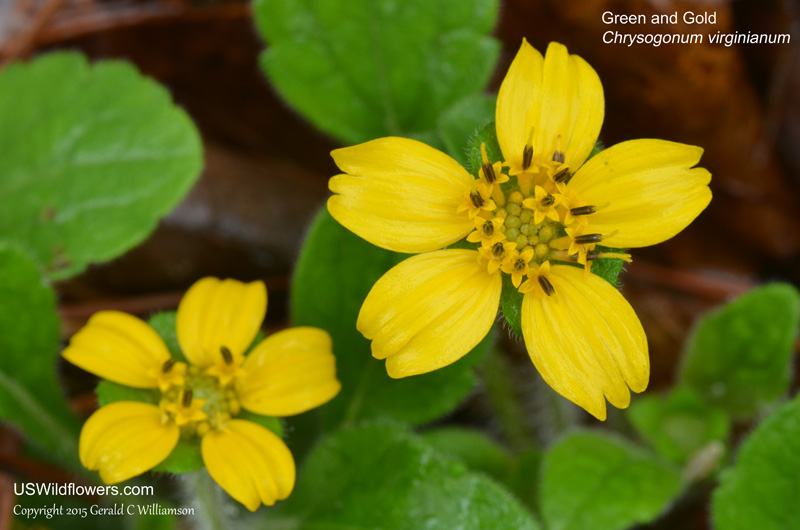
| | Site: Murray County, GA Date: 2015-April-17 | Photographer: Gerald C Williamson
Nikon D7000 | | Chrysogonum virginianum is found in low mats of bright green leaves and golden yellow flowers, yielding the common name Green and Gold. | | Click on the photo for a larger image
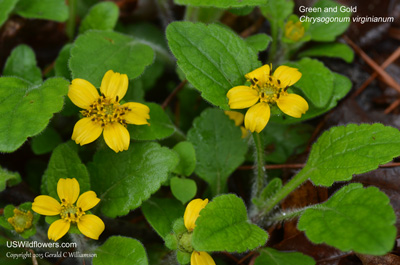
| | Site: Murray County, GA Date: 2014-April-17 | Photographer: Gerald C Williamson
Nikon D7000 | | The leaves of Green and Gold are primarily basal. Two varieties may also develop leaves on the flowering stems as the plant matures. The petioles are hairy, and depending on the variety, the face of the leaves are also variously hairy. The leaf blade may be up to 4 inches long. | | Click on the photo for a larger image
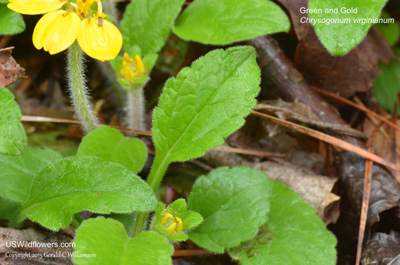
| | Site: Murray County, GA Date: 2014-April-17 | Photographer: Gerald C Williamson
Nikon D7000 | | While the vegetative stems are prostrate, the flowering stems are erect. | | Click on the photo for a larger image
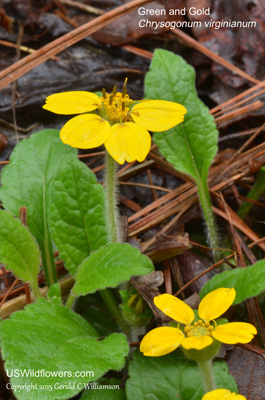
| | Site: Murray County, GA Date: 2014-April-17 | Photographer: Gerald C Williamson
Nikon D7000 | | Chrysogonum virginianum is found in low mats of bright green leaves and golden yellow flowers, yielding the common name Green and Gold. | | Click on the photo for a larger image
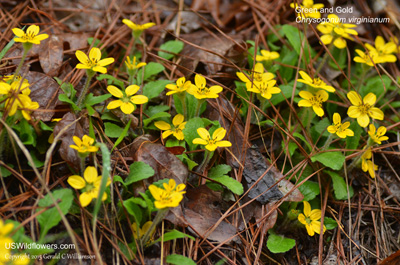
|
References used for identification and information:
|
|
| |
| #ad
|
|







